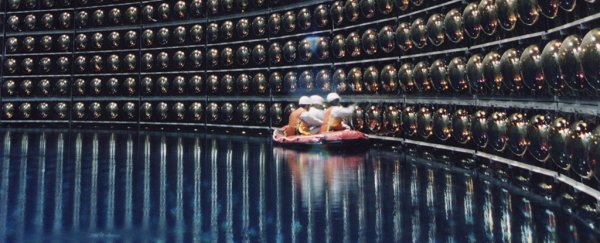Researchers studying the behaviour of electrically neutral particles called neutrinos might have finally found a solution to a mystery that has been confounding physicists for decades.
New results from the T2K experiment in Japan could explain why an equal amount of matter and antimatter did not form at the birth of the Universe, which has led to the stark imbalance we can still observe today.
According to the rules set by the standard model of particle physics and Einstein's theory of general relativity, the Big Bang should have produced equal amounts of both matter and antimatter.
But because matter and antimatter annihilate each other when they meet, leaving nothing but energy behind, this couldn't have actually happened, because equal matter and antimatter means no Universe.
Physicists refer to the imbalance between matter and antimatter in the observable Universe as baryon asymmetry.
This is where neutrinos come in. Also known as 'ghost particles', neutrinos are incredibly hard to detect, because they barely interact with the rest of the Universe. This means that experiments designed to measure them require incredibly sensitive instruments and a whole lot of observation time.
In addition to the neutrino, there's also its antimatter counterpart – the antineutrino – and they both come in three types: the electron, the muon, and the tau.
In 2013, scientists involved with the T2K project in Japan found the first evidence of neutrinos being able to change – or 'oscillate' – between these forms.
The T2K experiment involves more than 500 scientists from across the world and uses two sites some 300 km (186 miles) apart for its experimental country-wide labs: the Japan Proton Accelerator Research Centre (J-Parc) and the Super-Kamiokande observatory (pictured above).
Now, the latest results from T2K's continuing experiments are in, and they show evidence of 32 muon neutrinos becoming electron neutrinos, while just 4 muon neutrinos turned into their anti-electron counterparts.
The team behind the experiment don't fully understand what's going on here yet, but that's the kind of imbalance between matter and antimatter that scientists have been looking for all this time, and could offer evidence of a violation of what's known as charge-parity (CP) symmetry.
As Lisa Grossman from New Scientist explains, CP symmetry is the notion that physics would remain essentially unchanged if we replaced all particles with their respective antiparticles.
This implies that there should have been the same amount of matter and antimatter in the early Universe – which we know there wasn't, since we exist. So anything that shows a deviation from CP symmetry, like the neutrinos imbalance being observed by the T2K project, is important in helping to explain the discrepancy.
"We know in order to create more matter than antimatter in the Universe, you need a process that violates CP symmetry," physicist Patricia Vahle from the US-based NOvA Neutrino Experiment, who isn't involved with T2K, told Grossman.
Before we get too excited, it's worth noting that the T2K tests so far have only reached the second sigma level out of six.
These levels are used to verify and confirm discoveries in particle physics, and findings aren't considered confirmed until they reach level five, so it's early days yet. But the initial data suggests that this new study fits in well with the discoveries made three years ago.
Further antineutrino experiments are scheduled for next year, and the teams involved are planning to gather more data to help confirm their hypothesis.
Even then we won't know exactly how neutrinos and antineutrinos explain the baryon asymmetry problem, but we will know where to focus our investigations.
